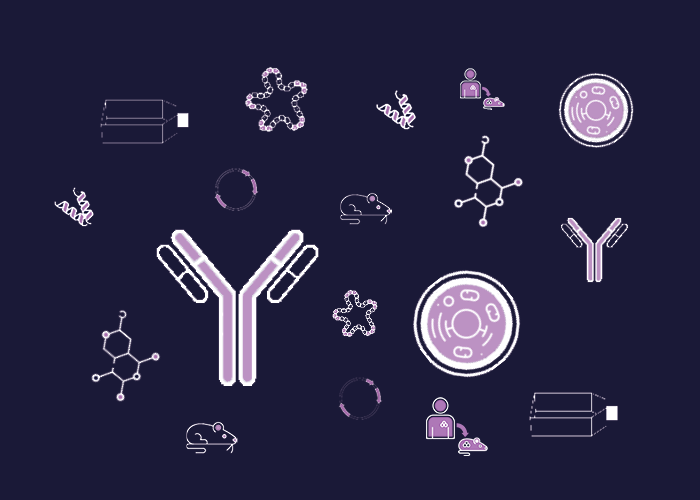
Cat. #155106
Anti-GalNAc-T3 [UH5]
Cat. #: 155106
Sub-type: Primary antibody
Unit size: 100 ug
Availability: 10-12 weeks
Target: GalNAc-T3/GALNT3
Class: Monoclonal
Application: ELISA ; IHC ; IF ; IP
Reactivity: Human
Host: Mouse
£300.00
This fee is applicable only for non-profit organisations. If you are a for-profit organisation or a researcher working on commercially-sponsored academic research, you will need to contact our licensing team for a commercial use license.
Contributor
Institute: University of Copenhagen
Tool Details
*FOR RESEARCH USE ONLY (for other uses, please contact the licensing team)
- Name: Anti-GalNAc-T3 [UH5]
- Alternate name: UH5, 2D1
- Research fields: Biochemistry;Cancer;Cell biology
- Tool sub type: Primary antibody
- Class: Monoclonal
- Conjugation: Unconjugated
- Strain: Balb/c
- Reactivity: Human
- Host: Mouse
- Application: ELISA ; IHC ; IF ; IP
- Description: GalNAc-T3 is one of many polypeptide GalNAc-transferases that attach GalNAc to proteins forming the GalNAc?ĂÂ?1-O-Ser/Thr linkage for GalNAc-type O-glycosylation. The GalNAc-transferase isoforms have considerably overlapping functions as well as unique distinct functions. GalNAc-T3 is differentially expressed in normal tissues e.g. pancreas, kidney, reproductive and gastrointestinal tracts. Genetic deficiency in GalNAc-T3 results in familial tumoral calcinosis and hyperostosis hyperphosphatemia syndrome due to lack of O-glycosylation of FGF23, which is a key regulator of serum phosphate homeostasis. GalNAc-T3 has also been implicated in spermatogenesis and carcinogenesis. O-glycans are important biomarkers in cancer. The truncated O-glycans comprising Tn formed by the GalNAc transferases and T formed by further elongation by the core1 synthase (C1GalT1) are widely recognized as pancarcinoma antigens. They are masked by sialic acid or further elongation or branching in normal cells. Validation: 1. Positive reaction (IC/IF) in cells expressing GalNAc-T3 using close isoforms as negative controls e.g. GalNAc-T6. 2. Selective IP of active GalNAc-T3 from total cell extracts. 3. Distinct perinuclear staining in cell lines (ICC/IF) and tissues (IHC, IF) suggestive of Golgi localization. 4. loss of staining (IC/IF) following KO of GalNAc-T3.
- Immunogen: Catalytically active secreted GalNAc-T3 produced in insect cells. Recombinant protein containing aa. 52-633 (Uniprot isoform-1)
- Immunogen uniprot id: Q14435
- Isotype: IgG1
Target Details
- Target: GalNAc-T3/GALNT3
- Target background: GalNAc-T3 is one of many polypeptide GalNAc-transferases that attach GalNAc to proteins forming the GalNAc1-O-Ser/Thr linkage for GalNAc-type O-glycosylation. The GalNAc-transferase isoforms have considerably overlapping functions as well as unique distinct functions. GalNAc-T3 is differentially expressed in normal tissues e.g. pancreas, kidney, reproductive and gastrointestinal tracts. Genetic deficiency in GalNAc-T3 results in familial tumoral calcinosis and hyperostosis hyperphosphatemia syndrome due to lack of O-glycosylation of FGF23, which is a key regulator of serum phosphate homeostasis. GalNAc-T3 has also been implicated in spermatogenesis and carcinogenesis. O-glycans are important biomarkers in cancer. The truncated O-glycans comprising Tn formed by the GalNAc transferases and T formed by further elongation by the core1 synthase (C1GalT1) are widely recognized as pancarcinoma antigens. They are masked by sialic acid or further elongation or branching in normal cells. Validation: 1. Positive reaction (IC/IF) in cells expressing GalNAc-T3 using close isoforms as negative controls e.g. GalNAc-T6. 2. Selective IP of active GalNAc-T3 from total cell extracts. 3. Distinct perinuclear staining in cell lines (ICC/IF) and tissues (IHC, IF) suggestive of Golgi localization. 4. loss of staining (IC/IF) following KO of GalNAc-T3.
Applications
- Application: ELISA ; IHC ; IF ; IP
Handling
- Format: Liquid
- Concentration: 0.9-1.1 mg/ml
- Unit size: 100 ug
- Storage buffer: PBS with 0.02% azide
- Storage conditions: -15° C to -25° C
- Shipping conditions: Dry ice
References
- A validated collection of mouse monoclonal antibodies to human glycosyltransferases functioning in mucin-type O-glycosylation.
- Exploring Regulation of Protein O-Glycosylation in Isogenic Human HEK293 Cells by Differential O-Glycoproteomics.
- Expression of the O-Glycosylation Enzyme GalNAc-T3 in the Equatorial Segment Correlates with the Quality of Spermatozoa.
- Deconstruction of O-glycosylation--GalNAc-T isoforms direct distinct subsets of the O-glycoproteome.
- Control of mucin-type O-glycosylation: a classification of the polypeptide GalNAc-transferase gene family.
- Polypeptide GalNAc-transferase T3 and familial tumoral calcinosis. Secretion of fibroblast growth factor 23 requires O-glycosylation.
- Mandel et al. 1999. Glycobiology. 9(1):43-52. PMID: 9884405.
- cDNA cloning and expression of a novel human UDP-N-acetyl-alpha-D-galactosamine. Polypeptide N-acetylgalactosaminyltransferase, GalNAc-t3.


